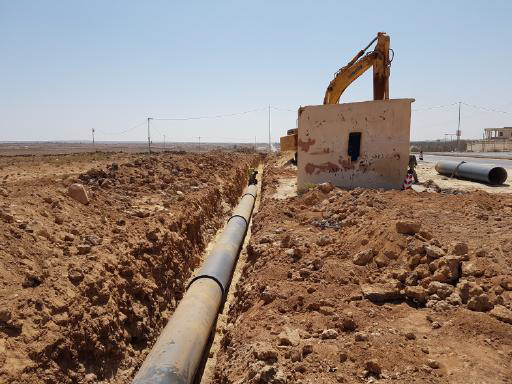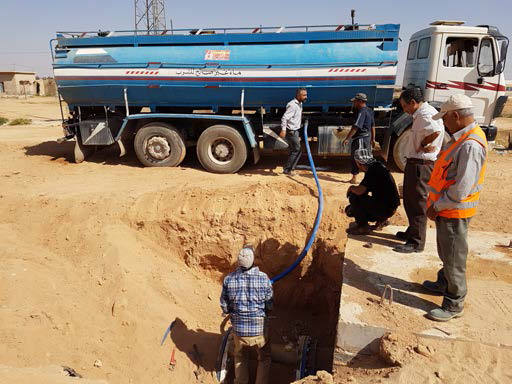Jordan has had to accept being labeled a Refugee Country since its independence, as the country has absorbed several waves of refugees from neighboring countries in a region of uncertainty. It began with the Arab-Israeli Wars in 1948 and 1967, followed by the Gulf Wars in 1991 and 2004, and ended with the most recent conflict in Syria, which added 1.4 million refugees to the country’s population. This posed extraordinary challenges to Jordan’s water sector, which lacked the necessary resources to meet the increased demand. Former UN High Commissioner for Refugees and current UN Secretary-General Antonio Guterres summed up Jordan’s experience in 2014, saying that “the simple act of providing water to Syrian refugees living in Jordan is a daily miracle.”
In addition, Jordan’s population has increased from 2 million in 1975 to around 10 million in 2020 due to a combination of organic growth and refugee influxes. Jordan’s urbanization has steadily increased, and in 2020, 91 percent of Jordan’s total population lived in urban areas and cities, up from 86 percent in 2010. The country’s population growth, improved living standards, and other social and economic developments have all contributed to an increase in municipal water demand.
The total municipal demand in 2020 was estimated to be 641 million cubic meters, and it is expected to increase by 31% by 2040, reaching 811 million cubic meters. This will result in a 148 percent increase in the supply gap between demand and available municipal water supply by 2040, reaching 530 million cubic meters. An estimated 20% of total water consumption in 2020 will be reliant on overexploited groundwater resources.
Even though Jordan contributed very little to climate change, it is expected to suffer far more than other countries, with less precipitation, dwindling groundwater resources, and rising temperatures in the forecast.
The UNFCCC predicts a 13.6 percent decrease in rainfall and a 1.6 degree Celsius increase in temperature by 2035. This would imply a 15% decrease in long-term groundwater recharge and a 15% decrease in long-term surface water runoff. As a result, available freshwater renewable water resources decreased from 500 m3 per capita per year to 140 m3 per capita per year between 1975 and 2010 and will be further reduced to 60 m3 per capita per year by the year 2035. This will pose exceptional challenges to Jordan’s water security unless the country develops new unconventional water resources to meet demand.
Furthermore, Jordan’s unique topography necessitates water pumping over extremely high elevational differences of more than 1,300m and long distances of more than 300km between available surface and groundwater resources and population centers. This has resulted in high operating costs, with electricity being the most significant contributor. One of the major challenges confronting the water sector is maintaining current water production while also securing the necessary investments to meet the country’s future water demand.
In terms of water management, the arrival of Syrian refugees in 2011 created a “crisis on top of a crisis.” The northern region was hardest hit by refugees, with the population increasing by more than 20% in just two years. The internal displacement of refugees resulted in a settlement pattern that differed markedly from previous crises. Around 85 percent of the refugees lived in host communities, adding to the strain on already overburdened systems. Prior to the crisis, the population was served by an intermittent water supply regime, which meant that there was no buffer to accept additional needs and demands.
The experience in dealing with the Syrian crisis has gifted the water sector with valuable lessons to become resilient in dealing with similar humanitarian and emergency scenarios.
1. Planning
Water and wastewater treatment projects typically have planning horizons of 25 to 30 years. The arrival of a large number of refugees necessitates earlier investments and raises future costs for water resource development. Donor assistance focuses on investments; however, operational costs are not covered. This jeopardizes the long-term viability of existing and new investments because Jordan’s government is unable to fund the additional resources required through its own revenues.
2. Fundraising
To maximize fundraising, it is critical to move away from short-term planning horizons and capitalize on short-term media attention. The fact that settling refugees in countries with similar socio-cultural backgrounds has reduced tensions and required much less funding (Germany, for example, has budgeted 12 billion EUR for settling 1 million refugees on its land) should aid in the more effective use of limited refugee support funds. Operating costs incurred as a result of providing services to refugees must be factored into the funding.
3. Coordination
For targeted and effective action, early coordination among all stakeholders is required. This contributes to lowering the enormous administration and management costs by establishing focal points within national authorities to coordinate and integrate ongoing investment programs and short-term humanitarian assistance.
Integration of refugees within host communities is preferable as a means of accommodating large numbers of refugees while limiting the establishment of temporary camps, but it can only be accepted if the international community guarantees the resources to reinforce and manage the related infrastructure. Establishing a nationwide related refugee development fund, rather than separate individual or bilateral funding arrangements, and having a multi-sector task force manage and use such funds is thus critical.
Final Remarks
The international community’s reduced support forces refugees to internalize within Jordan and migrate to other countries within and outside the Middle East region. Jordan is by far a stable country that has hosted a large number of refugees from various neighboring countries. Experience has shown that refugees stay for an average of ten years or longer, but international support typically declines over time due to ‘donor fatigue,’ which cannot be accepted. If the necessary international assistance is not secured, Jordan’s water sector will be driven from crisis management to a partial meltdown of service delivery, with serious consequences for stability.







